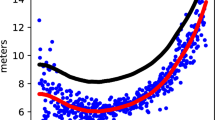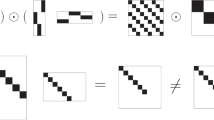Abstract.
A technique is proposed for Earth’s gravity field modeling on the basis of satellite accelerations that are derived from precise orbit data. The functional model rests on Newton’s second law. The computational procedure is based on the pre-conditioned conjugate-gradient (PCCG) method. The data are treated as weighted average accelerations rather than as point-wise ones. As a result, a simple three-point numerical differentiation scheme can be used to derive them. Noise in the orbit-derived accelerations is strongly dependent on frequency. Therefore, the key element of the proposed technique is frequency-dependent data weighting. Fast convergence of the PCCG procedure is ensured by a block-diagonal pre-conditioner (approximation of the normal matrix), which is derived under the so-called Colombo assumptions. Both uninterrupted data sets and data with gaps can be handled. The developed technique is compared with other approaches: (1) the energy balance approach (based on the energy conservation law) and (2) the traditional approach (based on the integration of variational equations). Theoretical considerations, supported by a numerical study, show that the proposed technique is more accurate than the energy balance approach and leads to approximately the same results as the traditional one. The former finding is explained by the fact that the energy balance approach is only sensitive to the along-track force component. Information about the cross-track and the radial component of the gravitational potential gradient is lost because the corresponding force components do no work and do not contribute to the energy balance. Furthermore, it is shown that the proposed technique is much (possibly, orders of magnitude) faster than the traditional one because it does not require the computation of the normal matrix. Hints are given on how the proposed technique can be adapted to the explicit assembling of the normal matrix if the latter is needed for the computation of the model covariance matrix.
Similar content being viewed by others
Author information
Authors and Affiliations
Corresponding author
Additional information
Acknowledgments. Professor R. Klees is thanked for support of the project and for numerous fruitful discussions. The authors are also thankful to Dr. J. Kusche for useful remarks and to Dr. E. Schrama, his solid background in satellite geodesy proved to be very helpful. A large number of valuable comments were made by Dr. S.-C. Han, Dr. P. Schwintzer, and an anonymous reviewer; their contribution is greatly acknowledged. The satellite orbits used in the numerical study were kindly provided by Dr. P. Visser (Aerospace Department, Delft University of Technology). Access to the SGI Origin 3800 computer was provided by Stichting Nationale Computerfaciliteiten (NCF), grant SG-027.
Rights and permissions
About this article
Cite this article
Ditmar, P., Sluijs, A. A technique for modeling the Earth’s gravity field on the basis of satellite accelerations. Journal of Geodesy 78, 12–33 (2004). https://doi.org/10.1007/s00190-003-0362-1
Received:
Accepted:
Published:
Issue Date:
DOI: https://doi.org/10.1007/s00190-003-0362-1




